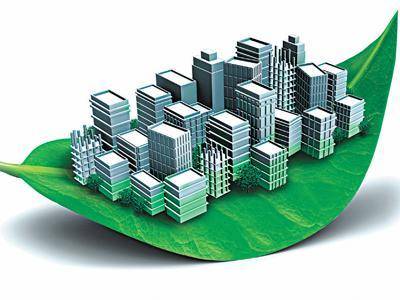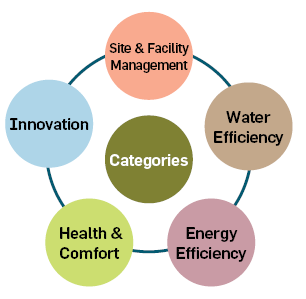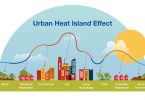We need more and more green buildings to preserve the very precious and quickly depleting natural resources of water, air, and energy. In addition to that, there is a growing need to green the existing building stock. That brings us the question – Can a home be certified IGBC if it has already been built? The answer is “Yes” – with IGBC Rating For Existing Homes.
There is massive scope for greening the already built buildings. In the recent years, new and modern green buildings are setting great examples on the environmental meter, but existing non-green buildings of the same size and structure have been consuming huge amounts of energy, water, and other valuable natural resources. Existing buildings cover a very hefty footprint of the built environment; thus, it is vital to find ways to reduce their water and energy consumption and improve their overall operational efficiency.
Green practices in the already built buildings can help address national urgencies like energy efficiency, water efficiency, reduction in the usage of fossil fuel, waste management and conservation of natural resources. In addition to that, two other most important aspect of greening the existing buildings is enhancing the health and well-being of its occupants.
IGBC (Indian Green Building Council) Rating For Existing Homes
IGBC, part of the Confederation of Indian Industry (CII) launched this unique rating system to address the critical sustainability characteristics in existing buildings. This rating programme was launched in 2013 during the Conference on Green Cities & Townships conducted in Mumbai.
IGBC rating for existing homes is a tool that facilitates building owners and facility managers implement green building strategies, measure its positive impact and withstand the performance over the lifecycle of the building.
Here is a quick rundown on the key highlights of this rating system:
- IGBC Green Existing Buildings is voluntary.
- It is designed to suit all types of buildings and for different climate zones. In addition to that, it includes both air-conditioned and non-air-conditioned buildings.
- Addresses green features under the following categories:
- Site & Facility Management
- Water Efficiency
- Energy Efficiency
- Health & Comfort
- Innovation
- The pilot version of IGBC Existing Buildings is relevant for all types of non-residential buildings which includes IT Parks, office buildings, BPOs, hotels, hospitals, shopping malls, banks, airports, etc.
- Factories and school buildings are not eligible, they can use other individual rating systems under IGBC as applicable.
- Buildings that are 80 percent occupied (with respect to carpet area) and are operational for a minimum period of 1 year are eligible for certification under this rating system. In addition, building projects which are already certified and operational for more than 1 year are also eligible.
- Campus projects which have many buildings can be considered as one solo project for registration and certification. But, individual buildings need to independently obey the water, energy and fresh air mandatory requirements.
- This rating system in comparison to other rating systems under IGBC has very less documentation requirement.
- Water management has maximum importance in this rating. For energy-related parts, the standards laid in Energy Performance Index (EPI) by BEE or Energy Conservation Building Code (ECBC) are recommended to be used.
- Levels of certification are:
- comprehensibly Certified for Best Practices – 50 – 59 Points
- cheapest pharmacy for accutane Silver for outstanding performance – 60 – 60 Points
- http://onpointengineering.co.uk/product-category/used-machinery/cnc-bridge-saws-used-machinery/ Gold for national excellence – 70 – 70 Points
- where can i buy Ivermectin Platinum for global leadership – 80 – 100 Points
- Certification is applicable for a period of 3 years from the date of issue.
Benefits Of IGBC Green Rating for Existing Buildings
Green rating for existing buildings can have great benefits, both tangible and intangible. The tangible ones include Energy savings (of 15-30 %) and Water savings (of 15-30%). On the other hand, Enhanced air quality, health and well-being of occupants, higher productivity, lower absenteeism and attrition, and demonstration of commitment towards the environmental stewardship and corporate social responsibility are the intangible ones.
A Dose Of Inspiration – Tata Bombay House
India’s First Heritage Building To Get IGBC Platinum Rating
The Tata group’s headquarters, Bombay House located in Mumbai, became India’s first heritage building to bag ‘Platinum Rating’ by the IGBC under their Existing Building Rating System in the year 2016.
The Bombay House received this rating for incessantly implementing measurable solutions and strategies in the below categories:
- Water Efficiency – By implementing measures like rainwater harvesting, ultralow flow fixtures and dual flushing system, the building has achieved water saving of more than 50 percent.
- Energy Efficiency – Estimating as per the Bureau of Energy Efficiency (BEE) Star Rating Index, the structure has achieved a 4-Star Energy Saving Rating. The building is capable of saving more than 20 percent energy. In the whole of 2013, it achieved an Energy Performance Index (EPI) of 124.96 kWh/ m2/year.
- Use of Off-Site Renewable Energy – Renewable Energy Certificates (REC) equivalent to more than 75% of the annual electricity consumption requirement of the building have been purchased. This was done to promote the use of green renewable energy in the building.
- Health & Comfort – Demand control ventilation, through CO2 sensor-based fresh air intake was installed to regulate fresh air quality inside the building. This enhanced health & ensured higher satisfaction levels for the occupants. They also accommodate special elevators to support the physically challenged. In addition, nearly 75 percent of the occupants of the building use carpools and/ or public transport.
- Beyond the Fence Initiative – Bombay house adopted measures to contribute to the maintenance of the common area in the neighbourhood which includes the ESSO Park with eco-friendly landscape practices, and Horniman Circle Park.
If all the existing buildings in the country start conserving water resources, improve the indoor air quality, enhance their energy efficiency, and eliminate waste, it will hugely improve the health and wellness of the occupants – Further resulting in noteworthy environmental benefits. Every drop of water and every unit of energy saved can be diverted to other deficit areas.
Building owner/ Project developer interested in IGBC Green Existing Buildings Certification for their project can register with IGBC on the IGBC Website.
Reference:
https://igbc.in/igbc/redirectHtml.htm?redVal=showGreenExistingBuildingsnosign
https://economictimes.indiatimes.com/news/politics-and-nation/tatas-bombay-house-indias-first-heritage-building-to-get-igbc-platinum-green-ratings/articleshow/51313652.cms
http://ishrae.in/newsdetails/Best-Practices-in-Existing-Green-Buildings-/438
https://www.thehindu.com/todays-paper/tp-features/tp-propertyplus/existing-buildings-can-now-go-green-with-igbc/article4707358.ece
You May Like:
The Story Of Indian Green Building Council (IGBC) Has Just Gone Viral!
Your Ultimate Reference Guide To IGBC Green Homes Ratings
Who Decides A Green Building Is Really Green? Know These Certifying Agencies Of India
Curated by editor at Wienerberger India
Like this story? Or have something to share? Write to us: gosmartbricks@gmail.com or connect with us on Facebook and Twitter.












